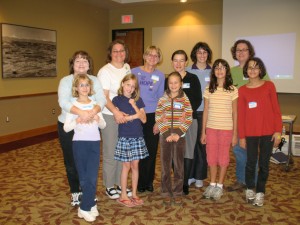 Yesterday Catherine and I went to see The Secret Life of Bees with our book club. It was a school holiday and Madeleine joined us, since we had previously read the book with her book club too. We enjoyed the movie, and there were quite a few tears flowing during the show. We also had an interesting discussion comparing the movie and the book over ice cream afterward.
Yesterday Catherine and I went to see The Secret Life of Bees with our book club. It was a school holiday and Madeleine joined us, since we had previously read the book with her book club too. We enjoyed the movie, and there were quite a few tears flowing during the show. We also had an interesting discussion comparing the movie and the book over ice cream afterward.
First I have to say we all liked the book hands-down better than the movie. The book is beautifully written, and it brings up issues of racism, familial love and acceptance of people for who they are. It’s not tidy, and by the end you know that the characters will go on trying to make sense of the times they live in and their reaction to them as well as to personal events in their own lives. There was lots of information about bee life that tied in as a wonderful metaphor to what the characters were experiencing.
While we liked the movie, we were very aware of things they changed from the book that made it flawed for us. For one thing, the movie seemed to add the bees as an afterthought, which seems strange. There were lots of scenes with August and Lily in bee clothing, but most of the bee talk seemed more informational about keeping bees and not metaphorical. Three other major differences between the book and the movie made up the bulk of our complaints about how the movie could have been better.
In the movie Zach ends up beaten up by white men for sneaking Lily, a white girl, into the colored section of a movie theater. This placed the blame on Lily and Zach for what came next. In the book, I was worried that something like that would happen because the two were so close, and I was glad when it didn’t. We all thought it was much better for the story for Zach to end up in jail, suspected of assaulting a white man even though he had done nothing. It showed how people tend to see faces different than their own as all looking the same, hence stripping the identity from an ethnic group. If you can get in trouble because all black people look alike to white people, then your individual actions cannot be counted on to set you apart.
Also, in the movie, Our Lady of Chains loses part of her story, and part of her significance. In the book, she is depicted as being a carved ship’s masthead that probably started out as a representation of a white woman, but through her trials and tribulations the color of her wood turned black. One of the girls mentioned she was a great symbol to show that we are all the same inside, regardless of the color of our skin, and she’s a bridge to heal racial issues. In the movie, she was depicted as being originally carved as a black woman, so the symbolism is lost.
The ending of the book was also much more satisfying than the ending of the movie, although we all got the feeling it was intended to be just the opposite. I won’t detail the endings except to say that in the book it’s not tidy, which is more like real life and more satisfying somehow. The movie wraps it all up in a nice tidy package that trivializes what’s come before. It felt trite to many of us.
Regardless of noticing things we liked or disliked about the movie and the book, we all thought it was a great discussion for our mother-daughter book club.







